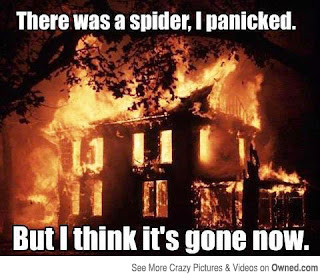I’m
not sure about all of you, but it seems fitting that this week the book in
question is Snow by Ronald Malfi—I haven’t
been warm in a week and I’m still in denial over the first snow of the season. I
finished the book under piles of blankets with a fleece zipped up to my chin, and I
still couldn't get warm. The reading material didn’t help the cause.
I
know I've mentioned in past blog posts that I’m not a fan of snow, or winter,
or being cold in general. I’d rather be too hot than too cold any day. Snow was the third piece this term that
was set in an extremely cold setting—first 30 Days of Night set the stage in Alaska, followed by The Thing in Antarctica, before
finishing up in Woodson, Minnesota with Snow.
The setting of Snow pulled double duty in this week’s book, and this was the first and
only of the term that’s done so. Not only is the setting enough to make your
skin crawl (literally, goose bumps abound) but the setting is the monster. Snow
itself is the beastie that goes bump in the night.
If
I didn't have enough issues with the cold…
It
all starts with Todd traveling cross-country to visit his son. However, all
flights are cancelled due to a freakishly intense snow storm. Todd decides to
rent a car anyway and drive the rest of the way to his son. At this point, it
was like watching a bad horror movie when screaming, “DON'T GO IN THERE!” at
the TV starts. One of the worst snow storms in history and we’re going to drive
in it. Insert face palm here.
But
how else are the hero and the people he picks up at the airport going to encounter
the monsters? It’s clear something strange is afoot after picking up a hitchhiker
with vertical slashes over his shoulder blades. Turns out he's been possessed
by the Snow. The Snow, or skin-suits as they’re later called, are these near-formless beings that need a host to become solid and feed. They attach and
insert themselves through the shoulder of their hosts by means of scythe-like limbs in place of hands. Any trace of the host is gone. Even
though the bodies can be destroyed, the Snow will only be damaged. Fire is their
only vulnerability, as the heat gives them solid form and strips them of
defense.
The
most unsettling thing about the Snow is what they do to children. For whatever
reason, the Snow can't inhabit a child-host without erasing all facial
features. It’s like “The Idiot's Lantern,” the episode of Doctor Who when Rose
loses her face. There's no explanation as to where the Snow came from, but it's
implied they're aliens.
While I did find the faceless children both disturbing and sad, I was
underwhelmed with these monsters. Aliens have popped up now three times this
semester, and so many of the monsters this term were reliant on a host. The hosts in Snow become zombie-like, and I'm starting to tire of
zombies. While the book was a fast read and I enjoyed aspects of it, these
monsters did nothing for me. It was three hundred pages of the main characters
running away from the Snow. Yes the Snow were active monsters, which I enjoy,
but there was a profound lack of backstory for them. Lack of backstory isn't always a bad thing, but they weren't the most interesting monsters I've read
about. I had a hard time getting invested in the quest to defeat the Snow.
Also, the end of the Snow was predictable. It was made clear around the middle of the book that they could be defeated by fire, so it felt like a long while before a big enough explosion came about to wipe them out. Yet the ending is left open. It's revealed that Woodson wasn't the only city plagued by the Snow, so the beastie-alien are free to run around the country looking for a bad enough snow storm to ride in on.
What
I enjoyed about this book was the dialogue and the setting. The
dialogue was fast paced and read how people talk. I appreciate a well-placed
juicy expletive because it’s real (or maybe my perception is warped because I
work with a bunch of sailor-mouths), and let’s face it. If someone’s running
away from the Snow with its scythe-hands of doom, “Oh fudge” probably isn’t
what would come out of most mouths.
I
also liked that the setting was both a setting and a monster. I've read books
where the setting absolutely contributed to the scare-level, but I liked that
Malfi took this a step further and had the snow become a perversion of nature. I
think it had more of an impact because it’s so cold right now. Might not have
thought about what’s riding on the cold wind so much if it was a balmy 80
degrees out.
Let's
just say, this book didn't change my opinion about snow, but I’m not sure if
that's a good or bad thing.





















.jpg)






.jpg)









